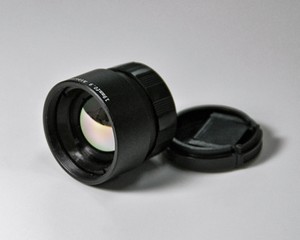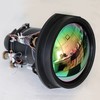Athermalized Thermal Imaging Camera Lenses
Featured Product from Hangzhou Shalom Electro-optics Technology Co., Ltd.

Features:
- Wide focal length range: 4.3mm to 100mm
- Broad working temperature range: -40? to 60?
- Passive optical athermalization design
- Compact structure and IP67 sealing
Infrared optical materials exhibit substantial changes in refractive index along with changes in temperature, this trait consequently leads to unstable focusing lengths of Infrared (IR) thermal imaging cameras, which are undesirable. Athermalization technique is often utilized in the design of IR thermal imaging to eliminate the defocus over an extended temperature range. There are three main techniques: Passive Optical Athermalization, Passive Mechanical Athermalization, and Active Electromechanical Athermalization. Passive Optical Athermalization eliminates the effect of defocus using combined different lens materials with complementing CTEs (Coefficients of Thermal Expansion) to compensate for thermal focus shift, the designed structure is simplified and involves no spacial displacement of the lenses, suitable for compact and light-weight applications.
Hangzhou Shalom EO offers off-the-shelf and custom LWIR thermal camera lenses of passive optical athermalization design, with a focus range of 4.3mm to 100mm and a temperature range of -40? to +60?. With passive optical athermalization treatment, the lenses are compact with the absence of additional optics to offset the thermal defocus and therefore are advantageous for weight-sensitive designs.
Tutorial:
This is a basic and brief tutorial to help you understand some important glossaries when you are selecting Optical Lenses and Camera Lenses.
Sensor Size and Resolution? The Sensor Size is the Width (Horizontal Length) and Height (Vertical Length) of the sensor/detector, often measured in mm, inch, or pixels. For Thermal Imaging Camera Lenses, Shalom EO gives the width and the height of the compliant detectors in pixels. Resolution is a measure of the image qualities, often given in ppi, which is the number of pixels per inch. For Thermal Imaging Camera Lenses, the resolution is given in the form of pixel pitch measured in μm.
Depth of Field (DOF): DOF is the distance between the nearest and the furthest objects which are in sharp focus in the image. Depth of Field could be calculated, providing the focal length, subject distance, and acceptable Circle of Confusion (CoC, a blurred spot resulting from the imperfect focus of point light sources, and the numerical value of acceptable CoC refer to the diameter of the blurred spot which is tolerable). and the f-number. Assume the focal length is f, subject distance is u, CoC equals c, and the f-number is n, then: DOF=2u^2nc/f^2
Focal Length: Focal Length is the distance from the optical center to the point at which radiations parallel to the optical axis of the lenses converge (i.e. the focal point). There is also Effective Focal Length (EFL), which is the distance from the principal point and the focal point, and Back Focal Length (BFL), which is the distance from the vertex of the rear lens to the back focal point.
Field of View (FOV): Field of View is the maximum angle within which an optical instrument is sensitive to electromagnetic radiation. It describes the visual scope of a camera and is determined by the focal length and the sensor size of the detector. In the specification forms, the FOV given is measured as angular values. Click Here to Learn More about FOV.
f-number: f-number, sometimes known as the f stop of the focal ratio, is the ratio of the focal length to the diameter of the entrance pupil (the aperture). The f-number indicates the ratio of radiations entering the lens, the greater the f-number, the smaller the aperture, and hence the less the radiations transferred. Also, lenses with a lower f-number appear crisper, since the blurring spot will become less perceptible on the image plane as the aperture contracts. The term “lens speed” also refers to the f-number of the lenses.
Transmission of Materials: It is important that the lens modules should be made from materials that have high transmission to your wavelength of interest. For instance, in the case of the MWIR thermal lenses, Germanium is a common material due to its wide optical transmission range from 2 to 12 microns. Thermal properties are another issue to consider, since the refractive index of optical materials varies as temperature varies, which leads to defocus of the lenses. Therefore for working conditions with fluctuated temperatures, athermalized lens modules are more appropriate. The weight of the material should also be evaluated for weight-sensitive applications.
Image Distortion: Image Distortion is defined as the deviation from a rectilinear perspective, the result is the bending over of straight lines into curved lines in the image. The greater the FOV, the more difficult it is to correct the spherical images into a rectilinear perspective. Fisheye Lenses tend to have a rather significant image distortion.
Modulation Transfer Function (MTF): Modulation Transfer Function is a comprehensive measurement to assess the ability of the optical lens to maintain contrast between line pairs of the real object at different spatial frequencies, where the distribution of light from the object is regarded as sinusoidal functions with specific frequencies. The greater the MTF value, the more capable is the camera of preserving the details from the real scene in the image.
Spherical Aberration and Coma: Spherical aberrations result from variations in the optical paths of light beams when passing through an optical lens' spherical surface. Monochromatic light beams that are incident on optical lenses but are not parallel to the optical axis tend to focus at the front of the mathematical focal point of the optics, while paraxial light beams that are closer to the optical axis tend to focus at the back of the mathematical focal point of the optics. Spherical aberrations can occur with lenses that have one or more spherical sides, including plano-convex lenses and ball lenses. When a cone of light from a point light source forms a defocused, comet-shaped, elliptical patch on the focal plane, coma, also known as comatic aberration, is said to be present. When the vertex of the cone of lights—the point light source—is not on the optical axis, this phenomenon takes place. Click here to learn more about spherical aberration and coma.
Chromatic Aberration: Chromatic aberration is a failure of a lens to focus all colors to the same point. It results from dispersion: the refractive index of the lens elements varies with the wavelength of light. Axial chromatic aberration is related to the focal distance of imaging, causing the separation of colors or flares; while magnification chromatic aberration is related to the magnitude of the imaging plane, causing color staggering around the screen, forming diffuse color fringes, this is known as the fringing phenomenon. Chromatic aberration affects the color reproduction of images on the color film and also reduces the resolution of images made on black and white film. The common approach to correct Axial Chromatic Aberrations is using an Achromatic Doublet Lens, and The correction of Magnification Chromatic Aberration to use lenses made from abnormal/ultra-low dispersion optical glass.
Field Curvature: Field Curvature, also known as “Curvature of Field” or “Petzval Field Curvature”, is a common optical problem. It is the phenomenon that an object plane perpendicular to the principal optical axis can not form a flat image field, but instead, the image field conjectured to be planar is inward bent into a curved, bowl-like shape. The consequence of field curvature is a flat object fractionally appearing sharp in a certain part(s) of the frame, instead of appearing sharp across the entire film frame. All optical lenses have, associated with it, a basic field curvature, which is a function of the index of refraction of the lens elements and their surface curvatures. The sharpest image can only be formed on a curved focal surface rather than a flat focal plane.
Astigmatism: Astigmatism is said to be present when the object point is not on the optical axis of the optical system, and the beam it emits has an inclination angle with the optical axis. Astigmatism is different from Coma. It is an off-axis aberration that describes the imaging defect of infinitely narrow beams and is only related to the field of view. The magnitude of the projection of the distance between the convergent point of the meridian narrow beam and the convergent point of the sagittal narrow beam on the optical axis is the value of astigmatism. Due to the presence of astigmatism, the image quality of the off-axis field of view is significantly reduced. Even if the aperture is opened very small, very clear images cannot be obtained in the meridional and sagittal directions at the same time. The size of the astigmatism is only related to the angular field of view, not the size of the aperture. Therefore, astigmatism is more obvious in the wide-angle lens, and the subject should be placed in the center of the picture as much as possible when shooting.
Note: You might want to learn more about lens selection, click here to view Lens Selection Guide to learn about different lens types and their aptness, and click here to view Optical Substrate Material Selection Guide to learn about material properties.











